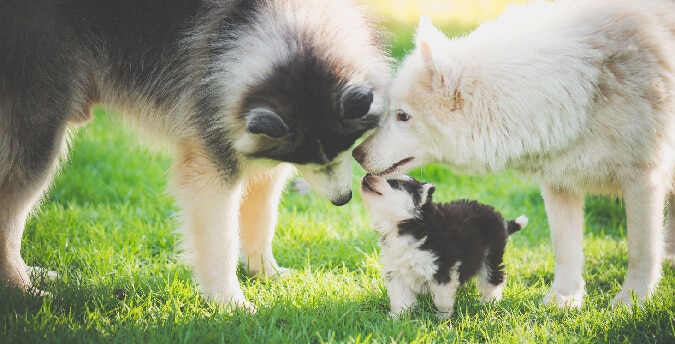Dog Life Stages

Dogs are like humans, as they go through different stages of life, which can determine their temperament, playfulness, and mobility. The needs of the dog often change depending on their age and how dependent they are on their owners. If you want to know how you can expect your four-legged friend to change in the coming years, you’ll need to understand the main dog stages of their life.
PUPPY
Once a dog is born, it immediately enters into puppyhood, which lasts six to 18 months. This is a time when the dog has high energy levels and wants to spend most of their time playing, whether it’s with a ball outside or tug-of-war with a rope. During this time, it’s also when they nurse the most from their mother while playing with their brothers and sisters. During this time, they can be separated from their mothers once they turn two months old and develop enough strength and independence, which is when other people tend to adopt dogs.
Once a puppy is old enough to be on its own, it’s the ideal time for an appointment to be scheduled with the vet to ensure they can undergo an exam to evaluate whether they’re healthy or not. Supplements are often provided to dogs that may be weak and need support to thrive and develop proper physical and mental performance. The vet will provide supplements to help them grow and remain healthy, as well as provide them with the necessary vaccinations.
Puppies should learn how to become potty trained when they’re at a young age to ensure they can avoid creating messes in the house. Using a crate and treats can prove to be useful in helping them learn how to use the backyard throughout the day.
At eight to 10 weeks, they often experience a lot of fear when joining a new family. Using positive reinforcements, like treats, can help them to feel more comfortable, especially when they’re riding in the car or are socializing with other pets. Experts recommend avoiding using pain or shock to train them, which can lead to long-term fear and anxiety throughout their life.
ADOLESCENT
Puppies begin to enter adolescence at the age of six to 18 months. Smaller breeds are known to become adolescents sooner than larger dogs. You may start to notice that the puppy is clumsy and is learning how to use its growing body, which is quickly becoming larger each week. Experts recommend performing obedience training during this time to ensure that it begins to obey well while learning different commands. The dog should be well-behaved at this point and feel like a member of the family.
ADULT
Dogs are considered to be adults when they’re three to six years old, which is also when they reach the height and size that is average for their specific breed and gender. They typically stop growing during this stage and require exercise throughout the week to release their energy. They also need mental stimulation to ensure they remain happy and don’t become bored at home.
Although adult dogs are often in the best shape of their lives and are thriving at this stage, they still need to visit the vet for routine check-ups and exams every few months. Due to how active dogs are at this age, they’re prone to suffering from paw issues as they play and run outdoors on rough terrain. Supplements can be provided to protect their feet and alleviate any discomfort or minor injuries.
SENIOR
For dogs, seniority occurs once they reach six years of age. It’s common for many types of breeds to begin suffering from health issues or conditions that can develop, which include joint pain or discomfort, lower energy levels, and a lack of mobility. It may take them longer to get around, or they may be slower to get up. Many older dogs are prone to sleeping more in the last years of their life and are less playful. Vision loss is also common in geriatric canines, but supplements can help to alleviate discomfort and reduce any side effects they may be experiencing. Helping the dog stay as active as possible with daily walks can help them to maintain their mobility and slow the aging process.
Understanding how your dog will change and when it will enter different stages of its life can help you to know what to expect and prepare. With the right knowledge, you can provide your pet with what they need to ensure they can thrive and have a happy and healthy life while they’re in your care.
